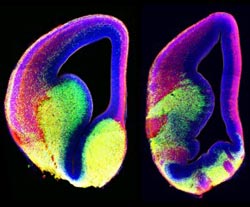Watching the Developing Brain, Scientists Glean Clues on Neurological Disorder

Eva Anton Lab, UNC School of Medicine<br> <br>The left panel shows normal neuronal cell organization (red and green). Organization is lost when Arl13b gene is deleted (right panel). <br>
A new study by researchers at the University of North Carolina School of Medicine reveals how some nerve cells, called interneurons, navigate during the development of the cerebral cortex. Mutations in a key gene behind this navigation system underlie a rare neurological disorder called Joubert syndrome; a condition linked with autism spectrum disorders and brain structure malformations.
The study was published online on Nov. 12, 2012 by the journal Developmental Cell.
“We were trying to understand how neurons get to the right place at the right time during brain development,” said senior study author Eva Anton, PhD, a professor in the UNC Neuroscience Center and the Department of Cell Biology and Physiology at the UNC School of Medicine.
To do that, the UNC researchers and their collaborator, Dr. Tamara Caspary, at Emory University tracked brain development in mice with and without a gene called Arl13b. They found that the gene, when functioning normally, allows interneurons to use an appendage called the primary cilium as a sensor.
These appendages are found on many types of cells, but scientists did not previously know what they were doing on developing neurons.
“We found that primary cilia play an important role in guiding neurons to their appropriate places during development so that the neurons can wire up appropriately later on,” said Anton. “It’s like an antenna that allows the neuron to read the signals that are out there and navigate to the right target location.”
Neurons in mice without the Arl13b gene or expressing mutant Arl13b found in Joubert syndrome patients essentially had a broken antenna, causing the cells to get lost on the way to their destinations.
Variants of the Arl13b gene are known to cause Joubert syndrome, which is characterized by brain malformations, abnormal eye and tongue movements, low muscle tone and mental retardation. This is one of the first studies to uncover how mutations of this gene actually disrupt brain development.
“Ultimately, if you’re going to come up with therapeutic solutions, it’s important to understand the biology of the disease,” said Anton. “This contributes to our understanding of the biological processes that are disrupted in Joubert syndrome patients.”
Co-authors include Holden Higginbotham, Tae-Yeon Eom, Amelia Bachleda, Joshua Hirt, Vladimir Gukassyana and Corey Cusack from UNC, Laura E. Mariani and Tamara Caspary of Emory University, and Cary Lai of Indiana University, Bloomington.
Media Contact
More Information:
http://www.med.unc.eduAll latest news from the category: Life Sciences and Chemistry
Articles and reports from the Life Sciences and chemistry area deal with applied and basic research into modern biology, chemistry and human medicine.
Valuable information can be found on a range of life sciences fields including bacteriology, biochemistry, bionics, bioinformatics, biophysics, biotechnology, genetics, geobotany, human biology, marine biology, microbiology, molecular biology, cellular biology, zoology, bioinorganic chemistry, microchemistry and environmental chemistry.
Newest articles

Superradiant atoms could push the boundaries of how precisely time can be measured
Superradiant atoms can help us measure time more precisely than ever. In a new study, researchers from the University of Copenhagen present a new method for measuring the time interval,…

Ion thermoelectric conversion devices for near room temperature
The electrode sheet of the thermoelectric device consists of ionic hydrogel, which is sandwiched between the electrodes to form, and the Prussian blue on the electrode undergoes a redox reaction…

Zap Energy achieves 37-million-degree temperatures in a compact device
New publication reports record electron temperatures for a small-scale, sheared-flow-stabilized Z-pinch fusion device. In the nine decades since humans first produced fusion reactions, only a few fusion technologies have demonstrated…





















